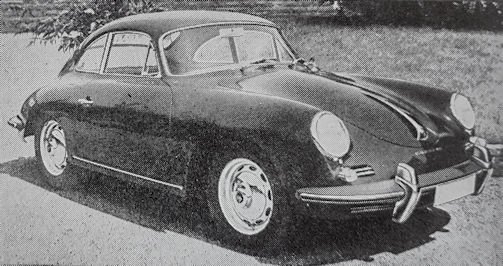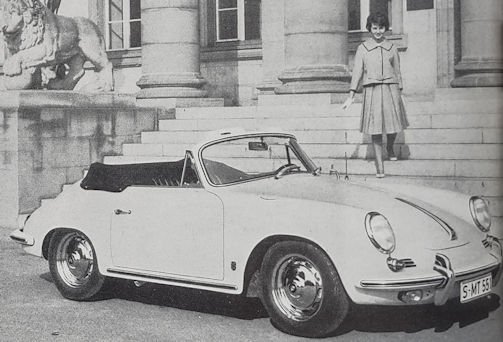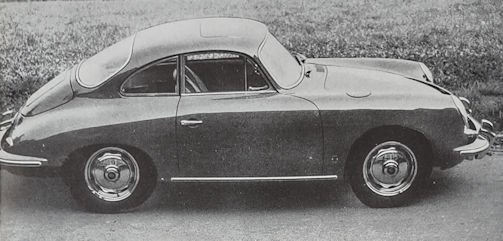Porsche 356 B
 |
|
|
Production period: |
1959 to 1963 |
|
Class: |
sports car |
|
Body versions: |
coupé, roadster |
|
Engines: |
1.6–2.0 litres |
|
Length: |
3950-4001mm |
|
Broad: |
1670mm |
|
Height: |
1290-1330mm |
|
wheelbase: |
2100mm |
|
curb weight: |
680-1010kg |
The Porsche 356 1959-1963 B The Porsche 356 was extensively revised in this model variant, which made the car appear more modern and elegant. Headlights and bumpers were raised, so the car appeared friendlier. The steering wheel received a sunken hub, rotating windows improved the fresh air supply and the rear window was kept fog-free by a heating nozzle.
The Porsche 356 was produced from autumn 1959 to 1961 as a coupé, cabriolet/hardtop and roadster (the roadster as the successor to the convertible D). From 1960, Karmann in Osnabrück also produced the "hardtop" with a permanently welded roof, which differed from the "classic" Porsche coupe in that it had a stepped roof line (almost like a notchback), narrow B-pillars and a large rear window, and the convertible hardtop resembled. Production of the roadster, which was last manufactured by D'Ieteren in Brussels, was discontinued at the end of 1961 (already as the 62/T6 model).
The main difference between the 356 B and the A-model was the higher headlights and the less rounded line of the fenders at the front. The bumpers were also placed higher, which enabled air inlets for the new alloy drum brakes in the front apron. However, the drag coefficient increased to 0.398. The Porsche crest was embossed into the hubcaps. Super 90 and Carrera (other models on request) received a compensating spring on the rear axle to reduce oversteer and counteract rear-end swerving during fast cornering. It was a single-leaf spring that was supported in the middle against the differential and both ends of which were attached to the axle tubes via tie rods and rubber elements. Regarding the possibility of the rear end swerving, Ferry Porsche said, “that the tendency to oversteer or understeer is no longer determined solely by the axle load distribution, but by the chassis tuning. The rear-engine car with an axle load distribution of 55% at the rear and 45% at the front could, if desired, be made into an understeered. However, the house of Porsche considers a slight oversteer tendency to be safer and therefore more useful.”

For the 1962 model year, the 356 B underwent the following changes, among others: engine cover with two air intake grilles, front or trunk lid with an almost straight end, tank filler neck on the outside under a flap on the right front fender, flatter tank in favour of a larger trunk, larger front and rear windows.
- PERFORMANCE: 356 B 1600 S
Engine capacity: 96.75 cu in, 1582 cu cm;
Fuel consumption: 34.4 m imp gal, 28.7 m US gal, 8.2 1 x 100 km;
Max speed:108.7 mph, 175 km h;
max power (DIN): 75 hp at 5500 rpm
max torque (DIN):81 1b ft, 11.9 kgm at 3700 rpm
max number of engine rpm: 5500
specific power:47,4 hp/l
max speed in 1st gear: 30 mph, 48.3 km h; max speed in 2nd
gear: 52 mph, 83.7 km/h; max speed in 3rd gear: 81 mph, 130.4 km/h; max 108.7 mph, 175 km/h
power-weight ratio: 27.6 lb./hp,12.5 kg/hp
acceleration: standing 1/4 mile 18.8 sec.(0—80 km/h) 10.6 sec
Sports versions of the B model
356 1600 GS Carrera GT (Coupe):
- 4-cylinder naturally aspirated engine (boxer), 1588 cm³, overhead camshafts with vertical shaft drive, 115 hp (85 kW) (up to model year 1961)
356 B Carrera GTL Abarth (Coupe):
- 4-cylinder naturally aspirated engine (Boxer), 1588 cm³, overhead camshafts with vertical shaft drive, 115 hp/85 kW at 6500 rpm (1960 - 20 pieces)
In addition to the standard 115 hp engine with 82-phon exhaust, Porsche offered two performance-enhanced versions: 128 hp (94 kW) at 6700 rpm with a sports exhaust and 135 hp (99 kW) at 7400 rpm with the open Sebring racing exhaust.
The technology largely corresponded to that of the 356 B model series, but Franco Scaglione designed a streamlined body for Abarth (Turin), which Zagato built from aluminium. Any luxurious interior was missing, saving about 140 kg compared to the 356 B for the road and about 20 kg compared to the Carrera GT from Reutter. The equipment of the "Abarth" included: dry sump lubrication, 12-volt electrical system, battery dual ignition, a four-speed gearbox that could be supplied with modified translations, a limited-slip differential, and an 80-liter petrol tank; Extras were a sports exhaust, special air funnels, seat belts, roll bars and wheels with central locks.
The top speed with the 135 hp engine was just over 230 km/h, with the standard engine around 210 km/h. In the most powerful version, the GTL Abarth accelerated to 100 km/h in 8.8 s and to 180 km/h in 26.5 s. With the first Abarth built, Herbert Linge /Hans-Joachim Walter won their class at the 24 Hours of Le Mans in 1960.

356 2000 GS Carrera 2 (Coupe and Convertible):
- 4-cylinder naturally aspirated engine (boxer), 1966 cm³, overhead camshafts with vertical shaft drive, 130 hp (96 kW) (from model year 1962)
- PERFORMANCE: 2-litre Carrera 1963
- Engine capacity: 120.24 cu in, 1966 cu cm;
- Fuel consumption: 21.7 m/imp gal, 18.1 m/US gal, 13 1 100 km;
- Max speed: 124.2 mph, 200 km/h;
- max power (DIN): 130 hp at 6200 rpm
- max torque (DIN).16.7 kgm at 5000 rpm
- max number of engine rpm: 6800
- specific power: 66.1 hp/l
- max speed in 1st gear: 32 mph, 51.5 km/h; max speed in 2ndgear: 57 mph, 91.8 km/h
- max speed in 3rd gear: 87 mph, 140.1 km/h; max 7.8 kg/hp
- useful load: 772 1b, 350 kg
- acceleration: 0—60 6.1 sec; speed in top at 1000 rpm. 19.6 mph, 31.5 km/h.
The Carrera 2 is the top model of the 356 series and the first production Porsche with disc brakes. These brakes were Porsche's own design, which differed from others in that the discs were gripped from the inside. The outer rim was therefore attached to a star-shaped hub carrier.
In the version as a touring car with 130 hp (acceleration from 0 to 100 km/h in 8.9 s according to the factory specification) The sports version 2000 GS-GT had doors and hood lid made of light alloy, a wooden steering wheel, side and rear windows made of Plexiglas; Rear seats and bumper guards were missing (bumpers are usually removed entirely for circuit racing). Engine output was increased to 155 hp (114 kW) at 6600 rpm; Compression 9.8:1. The GT has a 110 Liter tank (usually 50 litres), which is filled from the outside through a filler neck in the front hood.
2000GS Carrera GT
A Porsche prototype with a 2-liter engine and a body specially developed for high-speed circuits appeared for the 24-hour race in Le Mans in 1962: the front is pulled far down, the roof suddenly tears off, in contrast to the flowing course of the standard 356 rears.
In 1963 the Carrera 2 was given this or a very similar body as a works car under the designation Porsche 2000 GS-GT. At the Targa Florio, Edgar Barth /Herbert Linge finished third overall in this type and came first among all Gran Turismo cars. At the 1000 km race of the same year on the Nürburgring, the 2000 GS-GT under Hans-Joachim Walter/ Ben Pon /Herbert Linge/Edgar Barth came fourth overall and won the GT vehicles with up to 2 Liters displacement.
VARIATIONS AND OPTIONAL ACCESSORIES:
hardtop; transverse compensating on back axle; leather upholstery; limited slip final drive; A-speed mechanical box and overdrive fuel tank capacity: imp US gal, 80 1; 356 B 1600,
Technical
-
DIMENSIONS AND WEIGHT:
wheel base: 82.74 in, 2100 mm
front track: 51.46 in,1306 mm
rear track: 50.12 in, 1272 mm
overall length: 157.99 in, 4010 mm
overall width: 65.80 in, 1670 mm
overall height: 52.40 in, 1330 mm
ground clearance: 5.9 in, 150 mm
dry weight: 2062 1b, 935 kg
distribution of weight: 42 0/0 front axle, 58 0/0 rear axleENGINE: 356 B 1600
rear, 4 stroke; cylinders: 4, horizontally opposed
bore and stroke:3.25 x 2.91 in, 82.5 x 74 mm
engine capacity: 96.75 cu in, 1582 cu cm
compression ratio: 8.5 : 1
cylinder block: cast iron
cylinder head: light alloy
crankshaft bearings: 3
valves: 2 per cylinder, Vee-slanted, with push rods and rockers
camshaft: 1, central lower
lubrication: gear pump, filter on by-pass, oil coolerlubricating system capacity: 4.4 imp qt, 5.3 US qt, 5 1
carburation: 2 Zenith 32 NDIX twin barrel downdraft carburettors
fuel feed: mechanical pump
cooling system: air-cooled.TRANSMISSION:
driving wheels: rear
clutch: single dry plate
gear box:mechanical; gears: 4 + reverse
synchromesh gears: II,III, IV
gear box ratios:(I) 3.09, (II) 1.765, (III) 1.13, (IV) 0.815, (IV in USA 0.852), (Rev) 3.56
gear lever:central
final drive: spiral bevel; ratio: 4.428 : 1.CHASSIS:
semi-integral body
front suspension: independent, double swinging trailing arms, transverse laminated torsion bars, anti-roll bar, telescopic dampers
rear suspension: independent, swinging semi-axle, longitudinal radius arms. transverse torsion bars, telescopic dampers.STEERING:
cam and peg, damper
turns of steering wheel lock to lock: 2.5.
turning radius (between walls): 18 ft, 5.5 m;BRAKES:
drum, 2 front leading shoes
braking surface: total 122.14 sq in,ELECTRICAL EQUIPMENT:
voltage: 6 V
battery: 84 Ah
dynamo: 200 WENGINE: 2-litre Carrera
location rear. 4 stroke; cylinders: 4. horizontally opposed
bore and stroke:3,62 x 2.91 in. 92 x 74 mm
engine capacity: 120.24 cu in, 1966 cu cm
compression ratio:
cylinder block'. light alloy
cylinder head: light alloy
dual ignition
crankshaft bearings: 3
valves: 2 per cylinder, Vee-slanted
camshaft: 2 overhead for each cylinder block, driven by bevel gear shaft
lubrication: gear pump, filter on by pass, oil cooler
lubricating system capacity: 7.0 imp qt. 8.5 US qt
carburation: 2 Solex 40 PJJ-4 twin barrel downdraft carburettors
fuel feed: electric pump
cooling system: air-cooled.TRANSMISSION: 2-litre Carrera
driving wheels: rear
clutch: single dry plate
gear box: (I) 3,090, (II) 1.765, (III) 1.220, (IV) 0.855, (Rev) 3,560
gear lever: central
final drive: spiral bevel; ratio: 4.428 : 1.ELECTRICAL EQUIPMENT 2-litre Carrera
voltage 12 V, 84 Ah
dynamo: 200 WSpecifications - 1962 model year
Porsche 356B:
1600
1600p
1600 S-90
2000GS
Engine:
4-cylinder boxer engine (four-stroke)
Displacement:
1582cc
1966cc
Bore × Stroke:
82.5×74mm
92×74mm
Performance:
60 hp (44 kW)
at 450075 hp (55 kW)
at 500090 hp (66 kW)
at 5500130 hp (96 kW)
at 6200Max. torque at 1/min:
110 Nm at 2800
117 Nm at 3700
121 Nm at 4300
162 Nm at 4600
Compression:
7.5:1
8.5:1
9:1
9.2:1
valve control:
central camshaft, tappets, pushrods and rocker arms
DOHC*
(king waves)Cooling:
air cooling (blower)
Transmission:
4-speed gearbox with Porsche ring synchronization, stick shift
Front suspension:
Crank link axle with stabilizer
Rear suspension:
Pendulum axle with longitudinal thrust struts
Front suspension:
2 continuous square torsion bar springs on top of each other
made of individual spring leavesRear suspension:
1 round transverse torsion bar on each side
Body:
Box frame made of sheet steel,
body firmly connected to floor panTrack width front/rear:
1306/1272mm
Wheelbase:
2100mm
Tires rim:
165 – 4.5×15 Sport
165 – 4.5×15 (belt)
Dimensions L × W × H:
4010 × 1670 × 1330 mm (hard top 1315 mm)
curb weight:
Roadster: 870kg, 900-935kg
1010kg
Top speed:
160km/h
175km/h
180km/h
200km/h
- DOHC = double overhead camshaft; here: two overhead camshafts (left and right)
Service
-
356 B 1600
fuel: petrol, 85-90 Oct
engine sump oil: 3.0 imp qt.3.6 US qt, 3.4 1, SAE 20 HD (winter) 30 HD (summer). change every 1800 miles,3000 km
gearbox and final drive oil: 3.1 imp qt, 3.7 US qt. 3.5 1, SAE 90, change every 11200 miles, 18000 km
steering box oil: 0.2 imp qt. 0.2 US qt, 0.2 1, SAE 90
greasing: every 900 miles, 1500 km, 12 points
tappet clearances: inlet 0.004 in,0.10 mm, exhaust 0.006 in, 0.15 mm
valve timing: (inlet) opens 17° before tdc and closes 53° after bdc, (exhaust) opens 50° before bde and closes 14°after tdc
tyre pressure (medium load): front 21 psi,1.5 atm, rear 26 psiPorsche 2-litre Carrera 1963
fuel: petrol, 85-90 Oct
engine sump oil: 6.1 imp qt.7.4 US qt, 7.0 1, SAE 20 HD (winter) 30 HD (summer), change every 1800 miles, 3000 km
fuel tank capacity: 11.44 imp gal, 13.73 US© Motor car History
-Note: Advanced Maintenance and Repair Manuals available for registered users-
